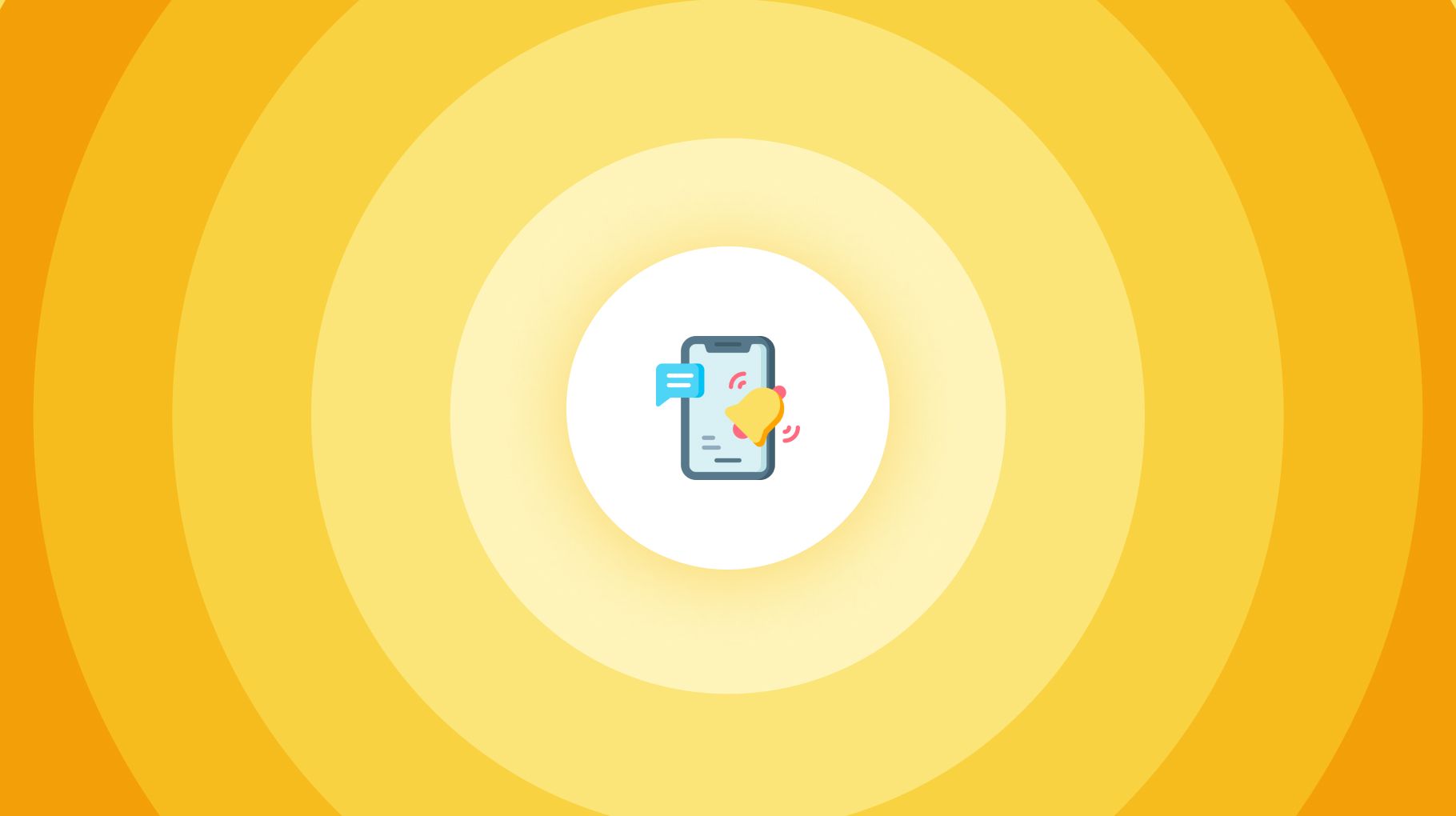Push Notifications Revenue and Growth Statistics (2024)

Amazing stats about Push Notifications
- US Gen-Z received 60% more push notifications in Q1 2023 than other countries.
- US iOS users, especially young ones, receive too many notifications from messaging apps, Snapchat, and email. Notifications will increase to 29 per day by January 2023.
- In a 2023 study across multiple countries (not including the US), people received an average of 12 push notifications daily, or 330 per month.
How many push notifications do users receive daily on apps worldwide?
Based on the statistics, it is clear that push notifications are being received in significantly higher numbers in the U.S. compared to other countries. In fact, during Q1 2023, push notifications in the U.S. were around 60% higher than those received in other countries. This trend is particularly pronounced among Gen-Z, who seems to be the age group that is being targeted the most by push notifications.
It is interesting to note that this trend is not limited to just one industry or sector. Rather, it seems to be a cross-industry phenomenon, with push notifications being used extensively by businesses of all kinds to reach out to their customers.
One possible explanation for this trend is the fact that Gen-Z, being digital natives, are more likely to engage with and respond to push notifications than other age groups. Additionally, the sheer amount of time that Gen-Z spends on their mobile devices makes them a particularly lucrative demographic for businesses to target via push notifications.
However, it is important to note that this trend may not necessarily continue into the future. As technology evolves and consumer preferences change, it is possible that the popularity of push notifications may wane in the coming years. Nonetheless, for the time being, it seems that push notifications are a powerful tool for businesses looking to engage with Gen-Z and other demographics on a large scale.
How many push notifications do users receive daily on apps in the United States?
Recent studies have revealed that the younger generation of iOS users in the United States receive an astonishing amount of notifications from their Messages app. By January 2023, it is predicted that these users aged between 16 and 25 will receive an average of 206 notifications per week, which translates to over 29 push notifications per day, with 2 during daytime hours.
Furthermore, dependence on technology has caused a surge in notifications from other popular apps like Snapchat and email. Snapchat notifications rank second with an average of 141 per week, while email notifications come third with an average of 137 per week. This trend of constant notifications is not only affecting the younger generation but also adults who rely heavily on technology for communication and work. As technology continues to advance, it is crucial to consider the impact it has on our daily lives and the need for balance in our use of technology.
Source: Statista
How many push notifications do users receive daily on apps in other countries?
According to a study conducted across various countries other than the United States, where the number of push notifications is far higher, users in this demographic received an average of 82 notifications per week on their Messages app as of January 2023.
This quantity is concerning, particularly when combined with an average of 12 push notifications per day and a staggering 330 push notifications per month.
What is the rate at which daily push notifications are actually viewed by users?
Based on studies conducted by push notification service providers, it is evident that almost 90% of push notifications get opened by users as they appreciate the targeted and personalized messages. However, it is important to note that not all users welcome push messages, and some might find them intrusive and annoying. This could be due to various reasons, such as receiving too many notifications or not finding them relevant.
Although push notifications have proven to be effective, they have gained a reputation for being unwelcome at times. This is mainly because a significant 10% of push notifications are never opened or viewed by users, and out of that 10%, about 5% will disable the notification. In other words, a substantial number of users are not responding to push messages.
Moreover, over 35% of push notifications are generic “broadcast” blasts to all users, highlighting the need for more personalized and relevant messages to enhance user engagement. Sending targeted and relevant messages can increase the likelihood of user engagement and desired actions.
It is, therefore, crucial for businesses to carefully consider the content and timing of push notifications. By providing users with personalized and relevant messages, businesses can increase user engagement and satisfaction while avoiding the possibility of being perceived as intrusive. Additionally, limiting the frequency of push notifications and allowing users to opt-out is crucial in maintaining a positive user experience.
Source: Upland Software
Overview of Push Notifications Opt-in rates
The Airship’s 2021 Push Notification Benchmark report provides insights on push notification opt-in rates for Android and iOS. The report reveals that app push notification opt-in rates on the Android OS range from 49% to 95%, with a median of 81%. This means that a majority of Android users are likely to receive push notifications from apps. In contrast, iOS push notification opt-in rates range from 29% to 73%, with a median of 51%. Although lower than Android’s median, it is still significant, and half of iOS users are likely to receive push notifications from apps.
It is important to note that iOS users must opt-in to receive push notifications, while Android users receive them automatically. This difference in default settings gives Android an advantage over iOS, which may explain why Android devices account for a majority of new device sales with 71.6%, compared to iOS’s share of 27.7% as of Q2 2022. The remaining percentage belongs to Samsung, KaiOS, and Nokia. However, it is interesting to note that Android’s edge over iOS has decreased compared to Q2 2021 when the split was 73% and 27%, respectively.
Push notifications have become an essential part of mobile app marketing strategies. They keep users engaged, informed, and up-to-date with the latest news, products, and services. Push notifications can be used for several purposes, like sending reminders, alerts, promotions, and personalized messages. The effectiveness of push notifications depends on various factors, including the content, timing, frequency, and relevance of the message.
As technology continues to evolve, it will be interesting to see how push notification opt-in rates change in the future. It is possible that iOS will catch up to Android in terms of push notification opt-in rates as more users become accustomed to receiving notifications on their mobile devices. On the other hand, Android may continue to dominate the market due to its default settings, making it easier for users to receive push notifications from apps.
Overall, push notifications are a powerful tool for businesses looking to engage with their customers on a large scale. By understanding the push notification opt-in rates on Android and iOS, businesses can tailor their marketing strategies to target the right audience and maximize their reach.
Source: Airship 1, Airship 2
How do users react to push notifications from apps?
Based on a recent survey conducted in 2021, it has been found that a significant portion of smartphone users in the United States are proactive in managing the overwhelming number of push notifications they receive. Specifically, 42% of users take measures such as changing their in-app settings to suit their preferences.
Furthermore, the analysis reveals that nearly 40% of users opted to disable all notifications related to the app in question. This suggests that app developers may need to reconsider the frequency and relevance of the notifications they send out, as they could be viewed as a nuisance by a sizable portion of the user base.
Interestingly, less than one in ten users chose to uninstall the app from their mobile devices to address the issue. This may be because the app in question had other useful features that the users did not want to lose access to. It could also reflect users’ preference to manage the notifications they receive rather than uninstalling the app entirely.
Source: Statista
Who are the top 10 Push Notification service providers?
When it comes to simplifying your engagement strategy, choosing the right push notification service is critical. With so many options available, it’s important to carefully consider each service’s functionality and pricing before making a decision that will impact your business.
In addition to simplifying your engagement strategy, push notifications have the potential to significantly enhance your customer experience. By providing timely and relevant information, you can keep your customers informed and engaged, ultimately leading to increased brand loyalty and revenue.
But with all these benefits, it’s important to note that push notifications can be a double-edged sword. If not used correctly, they can be seen as invasive and annoying, causing your customers to turn off notifications altogether. That’s why it’s important to carefully craft your messaging and understand your audience’s preferences.
So, take the time to explore your push notification service options and find the one that meets your needs. By doing so, you’ll be able to simplify your engagement strategy, enhance your customer experience, and ultimately drive business growth.
Source: Mobiloud
Overview of the Push Notification Marketing
Who sends push notifications?
Push notifications are an incredibly powerful marketing tool that businesses use to interact with users who have downloaded their app or visited their website. These notifications are initiated by the publisher and can be customized to fit the unique needs of the business. According to push notification statistics from VWO Engage, eCommerce businesses are the largest senders of push notifications, accounting for almost half of all notifications sent. Media, publishing, and blogging follow closely behind, making up another 10% of businesses sending push notifications.
However, it’s important to note that push notifications are not limited to just these industries. Banking and financial services, software and SAAS, and digital marketing agencies are also utilizing push notifications to reach their customers. While these industries only account for a small percentage of businesses sending push notifications, they are still finding great success with the tool.
When looking at the specific purposes for push notifications, it’s no surprise that eCommerce businesses primarily use them to announce offers and discounts. In fact, five out of six businesses in this sector use push notifications for this purpose. But don’t be misled – there are other innovative ways to use push notifications as well! Many businesses are achieving success with new product announcements or time-limited offers, which can create a sense of urgency and motivate users to take action.
Source: VWO
How do push notification senders predict user preferences?
According to recent statistics provided by VWO Engage, it seems that social media platforms are the preferred option for app push notifications among users. In fact, over half of the survey participants selected this particular option, indicating its popularity among users. However, it is interesting to note that news and information came in a close second, suggesting that users are not just interested in social media-related notifications. Despite this, none of the other options received more than a quarter of the responses.
It’s also worth noting that long-form media such as blogs and publications were at the bottom of the chart, with only slightly more than 9% of the survey respondents indicating a preference for push notifications from those sources. This implies that users tend to prefer shorter, more frequent reminders rather than longer, more in-depth notifications. This trend can be attributed to the conditioning effect of social media platforms such as Facebook, Twitter, and TikTok, which have trained users to expect frequent updates and reminders about new content.
Source: VWO
Overview of how to best prevent users from muting push notifications.
It is common for app users to receive a large volume of push notifications, with both positive and negative effects depending on the approach and industry. However, it is important to note that users have the option to decline notifications that are no longer relevant or meaningful, overly sales-oriented, too broad and impersonal, or sent at inappropriate times. Therefore, it is crucial to ensure that push alerts are crafted with care and consideration to optimize their impact on the user experience.
- To prevent this outcome, marketers should adjust the frequency of notifications based on the value they provide and each user’s specific tolerance level.
- To reduce the number of opt-outs, marketers should prioritize sending notifications that are customized according to the user’s purchasing stage, preferences, behavior, and personal information.
- Users highly value personalization, and by understanding their needs, personalized push messages can be developed to encourage continued use of the app.
What frequency of push notifications do U.S. users suggest?
A US smartphone user survey found that:
- Most people are okay with receiving message notifications a few times a day
- 13% think once a day is enough
- 25% are okay with notifications from news, email, and social media a few times a day
- 21% never want notifications for brand promotions on their phone
Source: Statista
Users’ preferred push notification frequency by age
The statistic shows the share of mobile users (by age group) that always or often allow an app’s request to allow push notifications. In 2017, 33 percent of survey respondents aged 18 to 34 years said that they always allow an app’s request for push notifications.
Source: Statista
Want more of this, for free?
About the author
Ch David is the co-founder of SignHouse. David is here to help the product development team expand the capabilities of ultimate eSignature maker for all your needs. Join David and the SignHouse team in stepping up electronic signatures!









